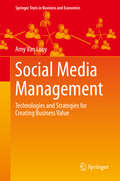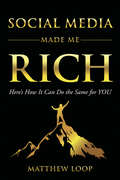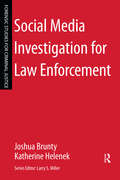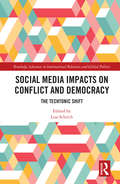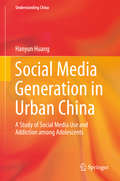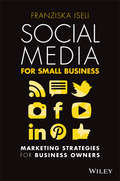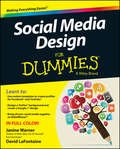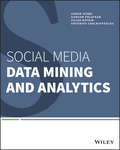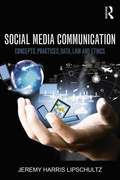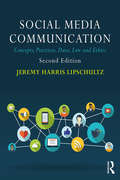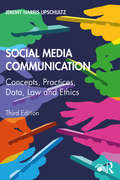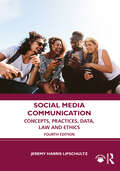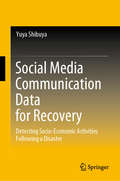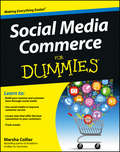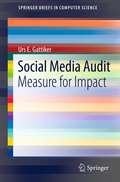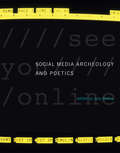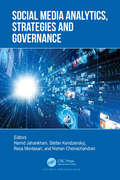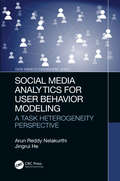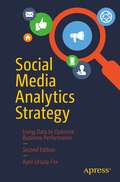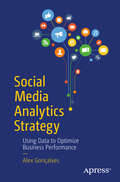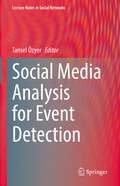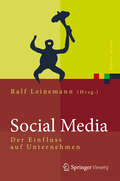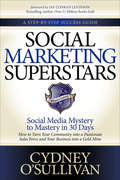- Table View
- List View
Social Media Management
by Amy Van LooyThis undergraduate textbook adopts the perspective of organizations - not individuals - and clarifies the impact of social media on their different departments or disciplines, while also exploring how organizations use social media to create business value. To do so, the book pursues a uniquely multi-disciplinary approach, embracing IT, marketing, HR and many other fields. Readers will benefit from a comprehensive selection of current topics, including: tools, tactics and strategies for social media, internal and external communication, viral marketing campaigns, social CRM, employer branding, e-recruiting, search engine optimization, social mining, sentiment analysis, crowdfunding, and legal and ethical issues.
Social Media Made Me Rich: Here's How it Can Do the Same for You
by Matthew LoopMatthew Loop has coached and trained thousands of entrepreneurs in more than twenty-five countries. Millions of people have viewed his free social media business-growth tutorials online. Now for the first time, he&’s packaged ten years of experience into a tactical blueprint that reveals the common denominators of the Internet's highest-paid movers and shakers. In Social Media Made Me Rich, he shows you how to harness these same strategies so you can profit big from networks like Facebook, Instagram, YouTube, Twitter, Pinterest, Amazon, and Google.
Social Media Investigation for Law Enforcement
by Joshua Brunty Katherine HelenekSocial media is becoming an increasingly important—and controversial—investigative source for law enforcement. Social Media Investigation for Law Enforcement provides an overview of the current state of digital forensic investigation of Facebook and other social media networks and the state of the law, touches on hacktivism, and discusses the implications for privacy and other controversial areas. The authors also point to future trends.
Social Media Intelligence
by Wendy W. Moe David A. SchweidelIn the world of Facebook, Twitter and Yelp, water-cooler conversations with co-workers and backyard small talk with neighbors have moved from the physical world to the digital arena. In this new landscape, organizations ranging from Fortune 500 companies to government agencies to political campaigns continuously monitor online opinions in an effort to guide their actions. Are consumers satisfied with our product? How are our policies perceived? Do voters agree with our platform? Measuring online opinion is more complex than just reading a few posted reviews. Social media is replete with noise and chatter that can contaminate monitoring efforts. By knowing what shapes online opinions, organizations can better uncover the valuable insights hidden in the social media chatter and better inform strategy. This book can help anyone facing the challenge of making sense of social media data to move beyond the current practice of social media monitoring to more comprehensive use of social media intelligence.
Social Media Impacts on Conflict and Democracy: The Techtonic Shift (Routledge Advances in International Relations and Global Politics)
by Lisa SchirchSocial media technology is having a dramatic impact on social and political dynamics around the world. The contributors to this book document and illustrate this "techtonic" shift on violent conflict and democratic processes. They present vivid examples and case studies from countries in Africa, South and Southeast Asia, Latin America as well as Northern Ireland. Each author maps an array of peacebuilding solutions to social media threats, including coordinated action by civil society, governments and tech companies to protect human minds, relationships and institutions. Solutions presented include inoculating society with a new digital literacy agenda, designing technology for positive social impacts, and regulating technology to prohibit the worst behaviours. A must-read both for political scientists and policymakers trying to understand the impact of social media, and media studies scholars looking for a global perspective.
Social Media Generation in Urban China
by Hanyun HuangSocial media such as instant messaging (IM), social networking sites (SNS), blogs and microblogs are an integral part of adolescents' lives in China. Anecdotal evidence reported in the news has suggested that the increasing popularity of social media could make adolescents more vulnerable to being addicted. This exploratory study proposes the concept of "social media addiction" and examines (a) whether social media addiction exists among adolescents in urban China and, if so, who the addicts are, what their symptoms are and to what extent they are addicted; (b) whether sociopsychological traits (e. g. , need for affiliation, impression management, narcissism and leisure boredom) can predict social media addiction among adolescents; (c) what gratifications are obtained by adolescents from their use of social media and whether these gratifications can predict social media addiction and (d) to what degree social media addiction influences adolescents' academic performance and social capital. This study employed quantitative questionnaire surveys among adolescents as the main research method, supplemented by qualitative pre-survey focus groups among adolescents and post-survey in-depth interviews among parents and teachers. Questionnaire surveys were conducted based on a multi-stage cluster sampling of seven middle schools in five urban Chinese cities: Beijing, Shanghai, Guangzhou, Shenzhen and Xiamen. The final sample consisted of 1,549 adolescents, of whom 90% had used social media. Using Young's classic definition of Internet addiction, 15. 6% of participants were classified as social media addicts. The addicted adolescents were often self-absorbed, bored with their leisure time, and good at using manipulation through social media for impression management. Addicts experienced four major social media addiction symptoms: preoccupation, adverse consequences, alleviation of negative emotions and loss of interest in social activities. The seven social media gratifications identified in this study can be categorized into social, information and entertainment gratifications. Among these, entertainment gratifications had the most power to predict social media addiction, while information gratifications were the least likely to lead to addiction. Furthermore, these gratifications were found to be powerful mediators between the adolescents' sociopsychological traits and social media addiction. Finally, the results also indicated that social media addiction and its symptoms had a significant negative impact on adolescents' academic performance and social capital.
Social Media For Small Business: Marketing Strategies for Business Owners
by Franziska IseliDiscover how social media can transform your business and help you attract more customers Social Media For Small Business delivers a step-by-step guide to unlocking the potential of social media to grow your business. Award-winning author and entrepreneur Franziska Iseli walks you through how to use Facebook, LinkedIn, Instagram, YouTube, Twitter, and Pinterest to market your small-to medium-sized business. The book provides you with: Effective marketing strategies to get more out of your social media efforts. Systems to bring structure into your entire marketing approach. Tools to make your brand irresistible across your customer touchpoints. Case studies to highlight the application of the book’s principles to the real-world Practical strategies you can put in place immediately to see a rapid return on investment Perfect for busy business owners, business managers and marketing teams wanting to find new and effective marketing tools to attract more customers, Social Media For Small Business also belongs on the bookshelves of anyone who has difficulty with or wants to learn more about how social media can have a positive impact on their business and brand.
Social Media Design For Dummies
by Janine Warner David LafontaineLearn to design professional and effective social media profiles!Whether you're trying to attract a new employer or get new fans to notice your brand, your social media profiles need to distinguish you from the masses. Packed with the secrets behind the hottest Facebook timelines, Twitter backgrounds, and LinkedIn profiles, this fun-but-straightforward guide shows you how to create eye-catching social media profiles with a professional, cohesive design.Includes online resources and downloadable templates that allow you to make your own profiles quick and easyReveals techniques for making a memorable and unique Twitter background, Facebook profile and page, LinkedIn profile, Google+ profile, and moreDetails ways in which to use Pinterest boards and cover photos to showcase your brandShows you how to make the most of Rebelmouse and YouTube.Social Media Design For Dummies is a must-have introductory guide to creating a professional, effective, and cohesive design that will better communicate your brand's story to future partners, employers, and customers.
Social Media Data Mining and Analytics
by Antonios Chalkiopoulos Gabor Szabo Gungor Polatkan P. Oscar BoykinHarness the power of social media to predict customer behavior and improve sales Social media is the biggest source of Big Data. Because of this, 90% of Fortune 500 companies are investing in Big Data initiatives that will help them predict consumer behavior to produce better sales results. Written by Dr. Gabor Szabo, a Senior Data Scientist at Twitter, and Dr. Oscar Boykin, a Software Engineer at Twitter, Social Media Data Mining and Analytics shows analysts how to use sophisticated techniques to mine social media data, obtaining the information they need to generate amazing results for their businesses. Social Media Data Mining and Analytics isn't just another book on the business case for social media. Rather, this book provides hands-on examples for applying state-of-the-art tools and technologies to mine social media - examples include Twitter, Facebook, Pinterest, Wikipedia, Reddit, Flickr, Web hyperlinks, and other rich data sources. In it, you will learn: The four key characteristics of online services-users, social networks, actions, and content The full data discovery lifecycle-data extraction, storage, analysis, and visualization How to work with code and extract data to create solutions How to use Big Data to make accurate customer predictions Szabo and Boykin wrote this book to provide businesses with the competitive advantage they need to harness the rich data that is available from social media platforms.
Social Media Communication: Concepts, Practices, Data, Law and Ethics
by Jeremy Harris LipschultzIn Social Media Communication: Concepts, Practices, Data, Law and Ethics, Jeremy Harris Lipschultz presents a wide-scale, interdisciplinary analysis and guide to social media. Examining platforms such as Twitter, Facebook, LinkedIn, Pinterest, Youtube and Vine, the book explores and analyzes journalism, broadcasting, public relations, advertising and marketing. Lipschultz focuses on key concepts, best practices, data analyses, law and ethics--all promoting the critical thinking professionals and students need to use new networking tools effectively and to navigate social and mobile media spaces. Featuring contemporary case studies, essays from some of the industry's leading social media innovators, and a comprehensive glossary, this practical, multipurpose textbook gives readers the resources they'll need to both evaluate and utilize current and future forms of social media. For more information about the book, supplementary updates and teaching materials, follow Social Media Communication online at: Facebook: https://www.facebook.com/SocialMediaCommunication Twitter: @JeremyHL #smc2015 SlideShare: http://www.slideshare.net/jeremylipschultz
Social Media Communication: Concepts, Practices, Data, Law and Ethics
by Jeremy Harris LipschultzIn the second edition of Social Media Communication: Concepts, Practices, Data, Law and Ethics, Jeremy Harris Lipschultz presents a wide-scale, interdisciplinary analysis and guide to social media. Examining platforms such as Facebook, Instagram, Snapchat, LinkedIn, YouTube and Pinterest, this book explores and analyzes journalism, broadcasting, public relations, advertising and marketing. Lipschultz focuses on key concepts, best practices, data analyses, law and ethics—all promoting the critical thinking professionals and students need to use new networking tools effectively and to navigate social and mobile media spaces. Featuring historical markers and contemporary case studies, essays from some of the industry’s leading social media innovators and a comprehensive glossary, this practical, multipurpose textbook gives readers the resources they’ll need to both evaluate and utilize current and future forms of social media. For more information about the book, supplementary updates and teaching materials, follow the Social Media Communication Facebook page, @JeremyHL on Twitter and the UNO Social Media Lab on SlideShare. Facebook: www.facebook.com/SocialMediaCommunication Twitter: @JeremyHL #UNOSML #SMC2018 #SMProfs SlideShare: www.slideshare.net/jeremylipschultz
Social Media Communication: Concepts, Practices, Data, Law and Ethics
by Jeremy Harris LipschultzThis updated third edition presents a wide-scale, interdisciplinary guide to social media. Examining platforms like Facebook, Instagram, LinkedIn, Snapchat, TikTok, Twitter and YouTube, the book analyzes social media's use in journalism, broadcasting, public relations, advertising and marketing. Lipschultz focuses on key concepts, best practices, data analyses, law and ethics – all promoting the critical thinking that is needed to use new, evolving and maturing networking tools effectively within social and mobile media spaces. Featuring historical markers and contemporary case studies, essays from some of the industry’s leading social media innovators and a comprehensive glossary, this practical, multipurpose textbook gives readers the resources they will need to both evaluate and utilize current and future forms of social media communication. Among other changes, updates to the third edition include a deep dive into new approaches to analytics, as well as greater discussion of law and ethics in light of the Facebook Cambridge Analytica scandal, the roll-out of GDPR and new case law relating to social media. Social Media Communication is the perfect social media primer for students and professionals, and, with a dedicated teaching guide, ideal for instructors, too.
Social Media Communication: Concepts, Practices, Data, Law and Ethics
by Jeremy Harris LipschultzThis updated fourth edition presents a wide-scale, interdisciplinary guide to social media communication. Examining platforms like Facebook, Instagram, Snapchat, TikTok, Twitter and YouTube, the book analyzes social media's use in journalism, public relations, advertising and marketing. Lipschultz focuses on key concepts, best practices, data analyses, law and ethics – all promoting the critical thinking that is needed to use new, evolving and maturing networking tools effectively within social and mobile media spaces. Featuring historical markers and contemporary case studies, essays from some of the industry’s leading social media innovators and a comprehensive glossary, this practical, multipurpose textbook gives readers the resources they will need to both evaluate and utilize current and future forms of social media communication. Updates to the fourth edition include expanded discussion of disinformation, the impact of artificial intelligence (AI), natural language chatbots, virtual and augmented reality technologies and the COVID-19 infodemic. Social Media Communication is the perfect social media primer for students and professionals and, with a dedicated online teaching guide, ideal for instructors, too.
Social Media Communication Data for Recovery: Detecting Socio-Economic Activities Following a Disaster
by Yuya ShibuyaThis book explores the possibility of using social media data for detecting socio-economic recovery activities. In the last decade, there have been intensive research activities focusing on social media during and after disasters. This approach, which views people’s communication on social media as a sensor for real-time situations, has been widely adopted as the “people as sensor” approach. Furthermore, to improve recovery efforts after large-scale disasters, detecting communities’ real-time recovery situations is essential, since conventional socio-economic recovery indicators, such as governmental statistics, are not published in real time. Thanks to its timeliness, using social media data can fill the gap. Motivated by this possibility, this book especially focuses on the relationships between people’s communication on Twitter and Facebook pages, and socio-economic recovery activities as reflected in the used-car market data and the housing market data in the case of two major disasters: the Great East Japan Earthquake and Tsunami of 2011 and Hurricane Sandy in 2012. The book pursues an interdisciplinary approach, combining e.g. disaster recovery studies, crisis informatics, and economics. In terms of its contributions, firstly, the book sheds light on the “people as sensors” approach for detecting socio-economic recovery activities, which has not been thoroughly studied to date but has the potential to improve situation awareness during the recovery phase. Secondly, the book proposes new socio-economic recovery indicators: used-car market data and housing market data. Thirdly, in the context of using social media during the recovery phase, the results demonstrate the importance of distinguishing between social media data posted both by people who are at or near disaster-stricken areas and by those who are farther away.
Social Media Commerce For Dummies
by Marsha CollierCapture customers and sales with social media commerceSocial media commerce is a booming industry. By using social networks in the context of e-commerce transactions, brands large and small are making their products more available and more convenient for customers. This one-of-a-kind guide introduces you to social media commerce and explains how you can use social media to provide better customer service, collect payments online, and build your customer base. Online marketing expert Marsha Collier helps you determine where you have the best opportunity to reach your market, which sites you should integrate with, and much more.Your customers are communicating with each other via social media; making purchasing opportunities available on social media sites adds convenience for your customer and opens up new sales opportunities This step-by-step guide explains social media commerce and shows what you can accomplish Helps you determine the sites where your business should have a presence Demonstrates how customers can help promote your brand as they recommend products and services to others on their social networks Author Marsha Collier is the undisputed expert on eBay and a recognized authority on social media marketingSocial Media Commerce For Dummies helps you offer your customers better service while giving them the opportunity to share information about your product with their social media contacts.
Social Media Audit
by Urs E. GattikerSocial media has drastically improved the way we can reach target audiences and serve our customers. Like its financial counterpart, the social media audit (SMA) can be described as a formalized review of anorganization's social media activities. However, contrary to financial audits, social media audits are not guided by government regulations or a set of professional rules and standards. This book will address social media marketing issues using a cost benefit approach, while presenting a systematic approach to review the organization's social media activities. Using the checklists and templates provided in this book will enable readers to conduct an audit that helps identify target areas for performance improvement and recommendations for how to achieve these objectives. Social media platforms discussed include: Facebook, LinkedIn, Google Plus, Twitter, Tumblr, and Xing.
Social Media Archeology and Poetics (Leonardo)
by Judy MalloyFirst person accounts by pioneers in the field, classic essays, and new scholarship document the collaborative and creative practices of early social media.Focusing on early social media in the arts and humanities and on the core role of creative computer scientists, artists, and scholars in shaping the pre-Web social media landscape, Social Media Archeology and Poetics documents social media lineage, beginning in the 1970s with collaborative ARPANET research, Community Memory, PLATO, Minitel, and ARTEX and continuing into the 1980s and beyond with the Electronic Café, Art Com Electronic Network, Arts Wire, The THING, and many more.With first person accounts from pioneers in the field, as well as papers by artists, scholars, and curators, Social Media Archeology and Poetics documents how these platforms were vital components of early social networking and important in the development of new media and electronic literature. It describes platforms that allowed artists and musicians to share and publish their work, community networking diversity, and the creation of footholds for the arts and humanities online. And it invites comparisons of social media in the past and present, asking: What can we learn from early social media that will inspire us to envision a greater cultural presence on contemporary social media?ContributorsMadeline Gonzalez Allen, James Blustein, Hank Bull, Annick Bureaud, J. R. Carpenter, Paul E. Ceruzzi, Anna Couey, Amanda McDonald Crowley, Steve Dietz, Judith Donath, Steven Durland, Lee Felsenstein, Susanne Gerber, Ann-Barbara Graff, Dene Grigar, Stacy Horn, Antoinette LaFarge, Deena Larsen, Gary O. Larson, Alan Liu, Geert Lovink, Richard Lowenberg, Judy Malloy, Scott McPhee, Julianne Nyhan, Howard Rheingold, Randy Ross, Wolfgang Staehle, Fred Truck, Rob Wittig, David R. Woolley
Social Media Archeology and Poetics
by Judy MalloyFocusing on early social media in the arts and humanities and on the core role of creative computer scientists, artists, and scholars in shaping the pre-Web social media landscape, Social Media Archeology and Poetics documents social media lineage, beginning in the 1970s with collaborative ARPANET research, Community Memory, PLATO, Minitel, and ARTEX and continuing into the 1980s and beyond with the Electronic Café, Art Com Electronic Network, Arts Wire, The THING, and many more.With first person accounts from pioneers in the field, as well as papers by artists, scholars, and curators, Social Media Archeology and Poetics documents how these platforms were vital components of early social networking and important in the development of new media and electronic literature. It describes platforms that allowed artists and musicians to share and publish their work, community networking diversity, and the creation of footholds for the arts and humanities online. Anditinvites comparisons of social media in the past and present, asking: What can we learn from early social media that will inspire us to envision a greater cultural presence on contemporary social media?ContributorsMadeline Gonzalez Allen, James Blustein, Hank Bull, Annick Bureaud, J. R. Carpenter, Paul E. Ceruzzi, Anna Couey, Amanda McDonald Crowley, Steve Dietz, Judith Donath, Steven Durland, Lee Felsenstein, Susanne Gerber, Ann-Barbara Graff, Dene Grigar, Stacy Horn, Antoinette LaFarge, Deena Larsen, Gary O. Larson, Alan Liu, Geert Lovink, Richard Lowenberg, Judy Malloy, Scott McPhee, Julianne Nyhan, Howard Rheingold, Randy Ross, Wolfgang Staehle, Fred Truck, Rob Wittig, David R. Woolley
Social Media Analytics, Strategies and Governance
by Hamid JahankhaniSocial media has spread rapidly on the global stage, driving consumers’ attention and influence, both consciously and subconsciously. Whilst this type of platform may have been initially designed as a tool for open communication and expression, it is also being utilized as a digital tool, with widescale use cases. The intelligence explosion, information overload and disinformation play a significant part regarding individual, group and country perceptions. The complex nature of this data explosion created an increasing demand and use of artificial intelligence (AI) and machine learning (ML), to help provide ‘big insights’ to ‘big data’. AI and ML enable the analysis and dissemination of vast amounts of data, however the ungoverned pace at which AI and autonomous systems have been deployed, has created unforeseen problems. Many algorithms and AI systems have been trained on limited or unverified datasets, creating inbuilt and unseen biases. Where these algorithmic tools have been deployed in high impact systems, there are documented occurrences of disastrous decision making and outcomes that have negatively impacted people and communities. Little to no work had been conducted in its vulnerability and ability to exploit AI itself. So, AI and autonomous systems, whilst being a force for societal good, could have the potential to create and exacerbate societies greatest challenges. This is a cohesive volume that addresses challenging problems and presents a range of innovative approaches and discussion.
Social Media Analytics for User Behavior Modeling: A Task Heterogeneity Perspective (Data-Enabled Engineering)
by Arun Reddy Nelakurthi Jingrui HeWinner of the "Outstanding Academic Title" recognition by Choice for the 2020 OAT Awards. The Choice OAT Award represents the highest caliber of scholarly titles that have been reviewed by Choice and conveys the extraordinary recognition of the academic community. In recent years social media has gained significant popularity and has become an essential medium of communication. Such user-generated content provides an excellent scenario for applying the metaphor of mining any information. Transfer learning is a research problem in machine learning that focuses on leveraging the knowledge gained while solving one problem and applying it to a different, but related problem. Features: Offers novel frameworks to study user behavior and for addressing and explaining task heterogeneity Presents a detailed study of existing research Provides convergence and complexity analysis of the frameworks Includes algorithms to implement the proposed research work Covers extensive empirical analysis Social Media Analytics for User Behavior Modeling: A Task Heterogeneity Perspective is a guide to user behavior modeling in heterogeneous settings and is of great use to the machine learning community.
Social Media Analytics Strategy: Using Data to Optimize Business Performance
by April Ursula FoxThis book shows you how to use social media analytics to optimize your business performance. The tools discussed will prepare you to create and implement an effective digital marketing strategy. From understanding the data and its sources to detailed metrics, dashboards, and reports, this book is a robust tool for anyone seeking a tangible return on investment from social media and digital marketing. Social Media Analytics Strategy speaks to marketers who do not have a technical background and creates a bridge into the digital world. Comparable books are either too technical for marketers (aimed at software developers) or too basic and do not take strategy into account. They also lack an overview of the entire process around using analytics within a company project. They don’t go into the everyday details and also don’t touch upon common mistakes made by marketers. This book highlights patterns of common challenges experienced by marketers from entry level to directors and C-level executives. Social media analytics are explored and explained using real-world examples and interviews with experienced professionals and founders of social media analytics companies. What You’ll Learn Get a clear view of the available data for social media marketing and how to access all of itMake use of data and information behind social media networks to your favorKnow the details of social media analytics tools and platforms so you can use any tool in the marketApply social media analytics to many different real-world use casesObtain tips from interviews with professional marketers and founders of social media analytics platformsUnderstand where social media is heading, and what to expect in the future Who This Book Is For Marketing professionals, social media marketing specialists, analysts up to directors and C-level executives, marketing students, and teachers of social media analytics/social media marketing
Social Media Analytics Strategy
by Alex GonçalvesThis book shows you how to use social media analytics to optimize your business performance. The tools discussed will prepare you to create and implement an effective digital marketing strategy. From understanding the data and its sources to detailed metrics, dashboards, and reports, this book is a robust tool for anyone seeking a tangible return on investment from social media and digital marketing. Social Media Analytics Strategy speaks to marketers who do not have a technical background and creates a bridge into the digital world. Comparable books are either too technical for marketers (aimed at software developers) or too basic and do not take strategy into account. They also lack an overview of the entire process around using analytics within a company project. They don’t go into the everyday details and also don’t touch upon common mistakes made by marketers. This book highlights patterns of common challenges experienced by marketers from entry level to directors and C-level executives. Social media analytics are explored and explained using real-world examples and interviews with experienced professionals and founders of social media analytics companies. What You’ll Learn Get a clear view of the available data for social media marketing and how to access all of itMake use of data and information behind social media networks to your favorKnow the details of social media analytics tools and platforms so you can use any tool in the marketApply social media analytics to many different real-world use casesObtain tips from interviews with professional marketers and founders of social media analytics platformsUnderstand where social media is heading, and what to expect in the future Who This Book Is For Marketing professionals, social media marketing specialists, analysts up to directors and C-level executives, marketing students, and teachers of social media analytics/social media marketing
Social Media Analysis for Event Detection (Lecture Notes in Social Networks)
by Tansel ÖzyerThis book includes chapters which discuss effective and efficient approaches in dealing with various aspects of social media analysis by using machine learning techniques from clustering to deep learning. A variety of theoretical aspects, application domains and case studies are covered to highlight how it is affordable to maximize the benefit of various applications from postings on social media platforms. Social media platforms have significantly influenced and reshaped various social aspects. They have set new means of communication and interaction between people, turning the whole world into a small village where people with internet connect can easily communicate without feeling any barriers. This has attracted the attention of researchers who have developed techniques and tools capable of studying various aspects of posts on social media platforms with main concentration on Twitter. This book addresses challenging applications in this dynamic domain where it is not possible to continue applying conventional techniques in studying social media postings. The content of this book helps the reader in developing own perspective about how to benefit from machine learning techniques in dealing with social media postings and how social media postings may directly influence various applications.
Social Media
by Ralf LeinemannDie Beiträge aus unterschiedlichen Unternehmen bieten eine fundierte Darstellung zum Einfluss sozialer Medien (Facebook, Twitter, LinkedIn, Xing, etc) auf die Kommunikation und Aussendarstellung von Unternehmen sowie auf interne Prozesse. Die Autoren erläutern zunächst den Einfluss auf interne und externe Kommunikation, die Kommunikationsqualität in sozialen Medien und die Chancen und Risiken der neuen Medien. Die Einflüsse auf die verschiedenen Unternehmensbereiche werden aus der Praxis heraus diskutiert. Zu den adressierten Bereichen gehören die Auswirkungen auf PR und Analyst Relations sowie auf Kommunikation und IT-Infrastruktur. In zwei abschließenden Kapiteln werden auch einzelne Branchen beleuchtet und ein internationaler Vergleich vorgestellt.
Social Marketing Superstars: Social Media Mystery to Mastery in 30 Days
by Cydney O'SullivanThe internet arrived with a boom changing the landscape for business and opening up a global marketplace like nothing before. The pace of change has been building with exponential momentum, the impact has hit, and the game has changed. Businesses all over the world are asking two big questions. How do we adapt while protecting our brand, assets & Intellectual Property? How do we incorporate the new technologies, mobility and social media into our business? Cydney O’Sullivan has spent the last decade working with business owners grappling with the challenges of taking their business online. She knew there had to be a better way, and sought out the success stories. Cydney interviews 30 forward thinking CEO’s and entrepreneurs who have built large, profitable communities using the technologies and networks we’ve all been grappling with like Google, Facebook, LinkedIn, Twitter, Youtube, eCommerce and Loyalty Programs. Learn how these seasoned entrepreneurs from around the world have adapted and applied technologies to become experts in their fields; many have created profits faster, more efficiently and more predictably than ever before in their businesses, as you answer these questions for your own business. What IS Social Marketing? Where does it fit in our business? How do we protect our Brand and Intellectual Property? How can we prepare our business for the future? With their success, for most of these entrepreneurs comes the opportunity to share this wealth of knowledge and experience to create a positive impact with their influence. This is the flame that fuels their entrepreneurial spirit beyond the quest for financial success alone.
